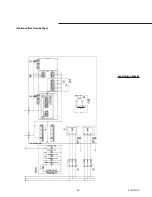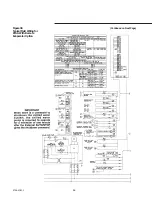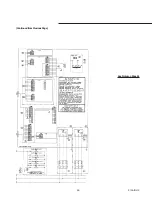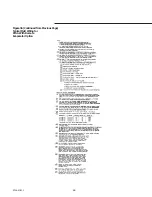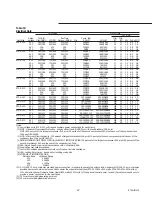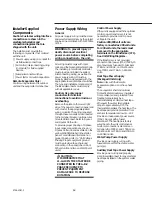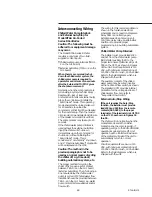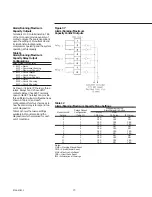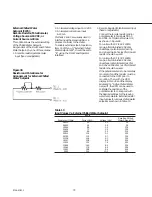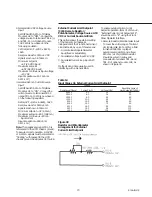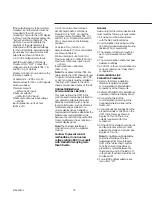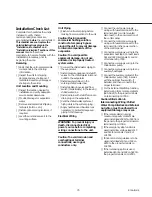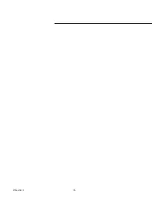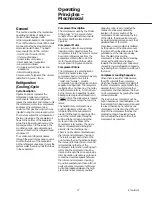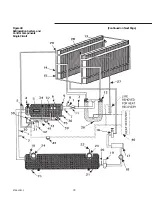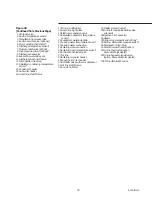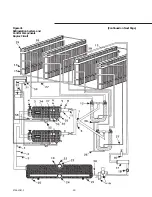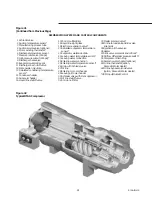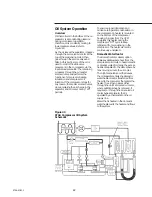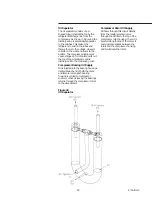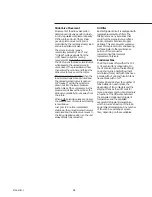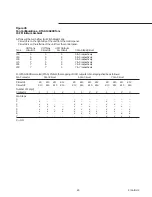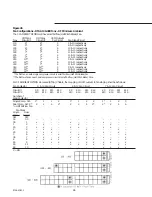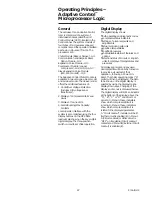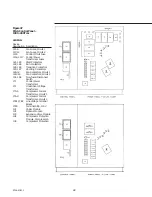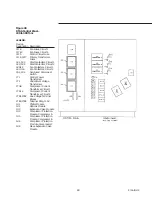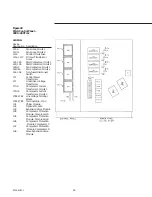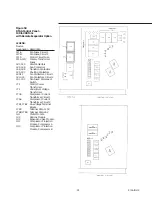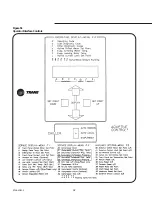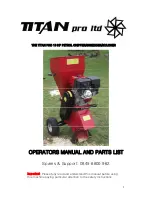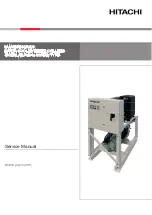
77
RTAA-IOM-3
Operating
Principles –
Mechanical
General
This section describes the mechanical
operating principles of Series R air-
cooled chillers equipped with
microcomputer-based control systems.
The 130 thru 400-ton Model RTAA units
are dual-circuited, helical-rotary type
air-cooled liquid chillers. The basic
components of an RTAA unit are:
- Unit Control Module (UCM)
- Unit-mounted panel
- Helical-rotary compressor
- Direct Expansion evaporator
- Air-cooled condenser
- Oil supply system (hydraulic and
lubrication)
- Interconnecting piping
Components of a typical RTAA unit are
identified in Figures 1 thru 6.
Refrigeration
(Cooling) Cycle
Cycle Description
Figures 40 and 41 represent the
refrigeration system and control
components. Vaporized refrigerant
leaves the evaporator and is drawn into
the compressor. Here it is compressed
and leaves the compressor as a
mixture of hot gas and oil (which was
injected during the compression cycle).
The mixture enters the oil separator at
the two in/out caps. The separated oil
flows to the bottom of the separator,
while the refrigerant gas flows out the
top and passes on to the tubes in the
condensing coils. Here circulating air
removes heat from the refrigerant and
condenses it.
The condensed refrigerant passes
through the electronic expansion valve
and into the tubes of the evaporator.
As the refrigerant vaporizes, it cools the
system water that surrounds the tubes
in the evaporator.
Compressor Description
The compressors used by the Model
RTAA Series “R” Air-cooled chiller
consists of two distinct components:
the motor and the rotors. Refer to
Figure 42.
Compressor Motor
A two-pole, hermetic, squirrel-cage
induction motor directly drives the
compressor rotors. The motor is cooled
by suction refrigerant gas from the
evaporator, entering the end of the
motor housing through the suction
line, as shown in Figures 40 and 41.
Compressor Rotors
The compressor is a semi-hermetic,
direct drive helical rotary type
compressor. Each compressor has only
three moving parts: Two rotors -
“male” and ‘female” - provide
compression, and a slide valve controls
capacity. See Figure 42. The male rotor
is attached to, and driven by, the motor,
and the female rotor is, in turn, driven
by the male rotor. Separately housed
bearing sets are provided at each end
of both rotors. The slide valve is located
above, and moves along, the top of the
rotors.
The helical rotary compressor is a
positive displacement device. The
refrigerant from the evaporator is
drawn into the suction opening at the
end of the motor barrel, through a
suction strainer screen, across the
motor, and into the intake of the
compressor rotor section. The gas is
then compressed and discharged
directly into the discharge line.
There is no physical contact between
the rotors and compressor housing.
The rotors contact each other at the
point where the driving action between
the male and female rotors occurs. Oil
is injected along the top of the
compressor rotor section, coating both
rotors and the compressor housing
interior. Although this oil does provide
rotor lubrication, its primary purpose is
to seal the clearance spaces between
the rotors and compressor housing.
A positive seal between these internal
parts enhances compressor efficiency
by limiting leakage between the high
pressure and low pressure cavities.
Capacity control is accomplished by
means of a slide valve assembly
located in the rotor section of the
compressor. Positioned along the top
of the rotors, the slide valve is driven
by a piston/cylinder along an axis that
parallels those of the rotors.
Compressor load condition is dictated
by the position of the slide valve over
the rotors. When the slide valve is fully
extended over the rotors and away
from the discharge end, the
compressor is fully loaded. Unloading
occurs as the slide valve is drawn
towards the discharge end. Slide valve
unloading lowers refrigeration capacity
by reducing the compression surface of
the rotors.
Compressor Loading Sequence
When there is a call for chilled water,
the UCM will start the compressor
which has the least number of starts. If
the first compressor cannot satisfy the
demand, the UCM will start another
compressor and then balance the load
on all compressors by pulsing the load/
unload solenoids.
The load on the compressors will be
kept in balance, as load fluctuates, until
the demand for chilled water is reduced
to a level that can be handled by one
compressor. At this time, the UCM will
drop off the compressor that has the
greatest number of operating hours
and will adjust the load on the other
compressor, as required.
Summary of Contents for RTAA-130
Page 2: ... American Standard Inc 1991 ...
Page 8: ...8 RTAA IOM 3 ...
Page 24: ...24 RTAA IOM 3 ...
Page 50: ...50 RTAA IOM 3 Figure 30 Refrigerant Circuit Identification ...
Page 52: ...52 RTAA IOM 3 Figure 31 Remote Evaporator Piping Example ...
Page 59: ...59 RTAA IOM 3 Continued from Previous Page See Notes on Next Page ...
Page 63: ...63 RTAA IOM 3 Continued from Previous Page See Notes on Page 61 ...
Page 65: ...65 RTAA IOM 3 Continued from Previous Page See Notes on Page 61 ...
Page 76: ...76 RTAA IOM 3 ...
Page 92: ...92 RTAA IOM 3 Figure 51 Operator Interface Controls ...
Page 120: ...120 RTAA IOM 3 ...
Page 127: ...127 RTAA IOM 3 Continued from Previous Page 2307 1566C ...
Page 128: ...128 RTAA IOM 3 Figure 57 Unit Sequence of Operation RTAA 130 to 200 Tons 2306 9122A ...
Page 132: ...132 RTAA IOM 3 Figure 58 Operator s Log ...
Page 138: ...138 RTAA IOM 3 ...

